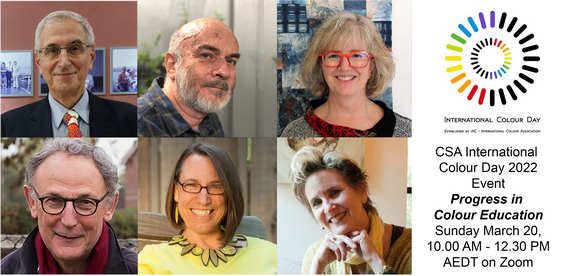
For our International Colour Day 2022 event, six of the ten members of the committee of the ISCC/AIC Colour Literacy Project from around the world will speak on different aspects of colour education. The Colour Literacy Project is a joint initiative of the American Inter-Society Colour Council and the International Colour Association formed to explore colour education from a multidisciplinary perspective of connections between science, art, design, industry, technology, and culture. CLP Co-chair Robert Hirschler (Hungary) will present the keynote address, a critical review of the seven "contrasts" of Johannes Itten, co-authored with committee member Andreas Schwarz (Germany), David Briggs (NSW) will illustrate alternative frameworks available today for visualizing colour relationships for different purposes, and Robin Kingsburgh (Canada) will discuss her remarkable multidisciplinary colour course at York University. These presentations will be followed by two short reports, one by Paul Green-Armytage (WA) on two related workshops conducted with Sean Adamas, and the second by CLP Chair Maggie Maggio and Luanne Stovall (USA) giving an update on activities of the Colour Literacy Project. The session will be chaired by CSA Past President Jean Pretorius. Please note that our ICD event this year will be held on March 20, the day before International Colour Day, which falls on March 21 every year.
This will be another free online event in the series we have been running since the beginning of the covid pandemic. The deadline for booking is midnight AEDT on March 18, but please note that this event may be booked out well before that date. Successful registrants will receive a confirmation email immediately and a second email with the Zoom link on March 19. Recordings of the presentations will be made available to CSA members on the CSA website. Please help us to spread information about this special event by means of social media and word-of-mouth, or by distributing the pdf poster that can be downloaded here.
We'd also like to announce that another member of the CLP committee, Ingrid Calvo Ivanovic, will be presenting on April 22/23 for the Colour Literacy Project's inaugral Colour Literacy Forum, an online gathering of educators discussing the state of colour-focused teaching and learning at universities. For more information on this event please see below under "Other Notices".
PRESENTATIONS
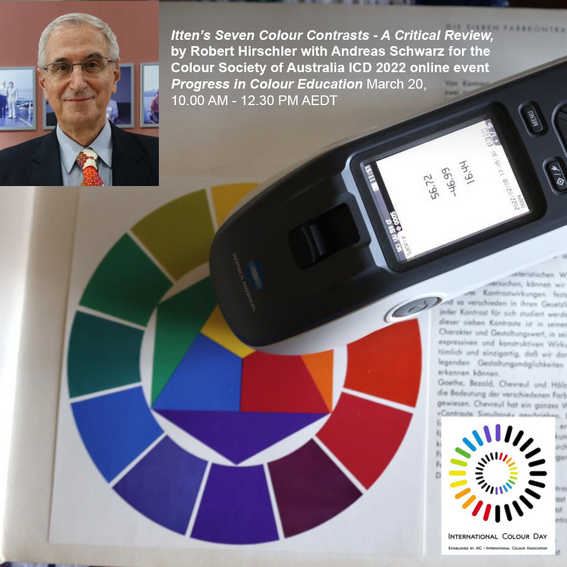
1. Itten’s Seven Colour Contrasts – a Critical Review, presented by Robert Hirschler and co-authored with Andreas Schwarz (Keynote presentation)
Itten’s contrast theory is a fundamental part of his teaching. His seven contrasts are known, described and taught in many parts of the world, yet they are not without problems and contradictions. With his theory of colour contrasts, Itten made a contribution to cultural history that should not be underestimated and that remains as a fact. However, for the understanding of a differentiated use of colour, be it receptive or productive, be it in the field of design, fine arts or even school, the seven colour contrasts do not come close to meeting today's level of knowledge and didactic requirements. We shall describe examples with not only perceptual but, in some important cases, also physical and psychometric characterization; and shall discuss the pros and cons of making students learn and make use of the seven contrasts.
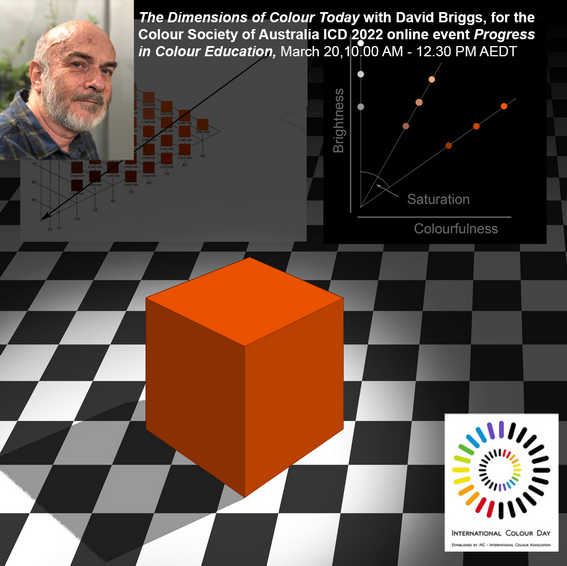
2. The Dimensions of Colour Today, presented by David Briggs
A limitation of much colour education in art and design over the last fifty years has been in its treatment of the dimensions of colour, which have typically been presented in terms of a single two-dimensional hue circle or “colour wheel”, very often in a form embodying historical beliefs about three “primary colours”, alongside a separate lightness (tone or value) scale. Even when colour has been considered three-dimensionally, it has usually been with the assumption that a single set of three colour attributes suffices for all purposes and for all modes of colour appearance, and that these attributes can be adequately represented as a simple symmetrical solid, usually a sphere. Nevertheless, there have been numerous positive developments stemming from several sources in the nearly 15 years since I addressed these issues in my outreach website The Dimensions of Colour, and in this talk I will highlight some of these developments and give an overview of the alternative frameworks available today for visualizing colour relationships.

3. Understanding Colour: Teaching the Science of Colour, presented by Robin Kingsburgh
Colour is a compelling topic that plays an important role across many disciplines. Although most often taught within the milieu of art and design, colour and colour phenomena provide an ideal entryway into science. Understanding Colour is a full-year course offered at York University's Division of Natural Science in the Faculty of Science, and has been taught by the author for over 20 years. The course examines colour from multi-disciplinary perspectives, including history, physics, chemistry, biology, and astronomy, as well as art. With a hands-on ‘kitchen science’ approach, students explore various colour phenomena (including mixing coloured media) within the framework of the scientific method. The course has been highly successful at York University, receiving many positive yearly reviews from students who are always surprised at how colour turns up in their everyday lives. Teaching the science of colour within the ‘general education’ context is valuable – to help improve science literacy and develop critical thinking skills. It is also valuable for artists and designers, giving them a deep and comprehensive understanding of colour without daunting technical detail, and enhancing or augmenting their work in unexpected ways.
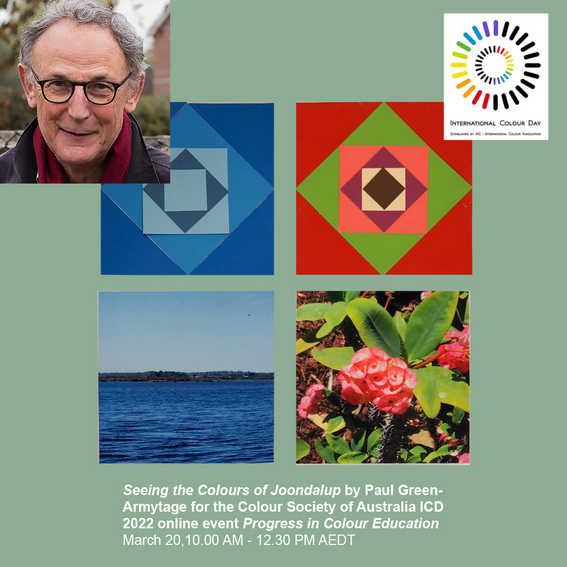
4. Seeing the Colours of Joondalup, presented by Paul Green-Armytage
This report will describe two related workshops conducted by Paul Green-Armytage and Sean Adamas for the City of Joondalup. (Joondalup is about 25 km north of the Perth CBD). Sean is working on hART –My Neighbourhood, a major installation for the Joondalup Festival (March 11 - April 2), that will feature the work of school children and community groups including the Colour Society. Participants at the workshops produced photographic collages and colour designs for inclusion in Sean’s installation. The first workshop – Walking, Looking, Seeing – was part of an on-going project of the Colour Society of Australia. We are developing awareness of ‘localness’ – appearances characteristic of a particular place – and especially how appearances change with weather conditions and at different times of day. The second workshop – Capturing the Colour Character of a Scene – was a development of an exercise presented at previous events in Perth and Boston, USA. The exercises in both workshops are prototypes for possible activities that could be suggested for schools as part of the Colour Literacy Project.
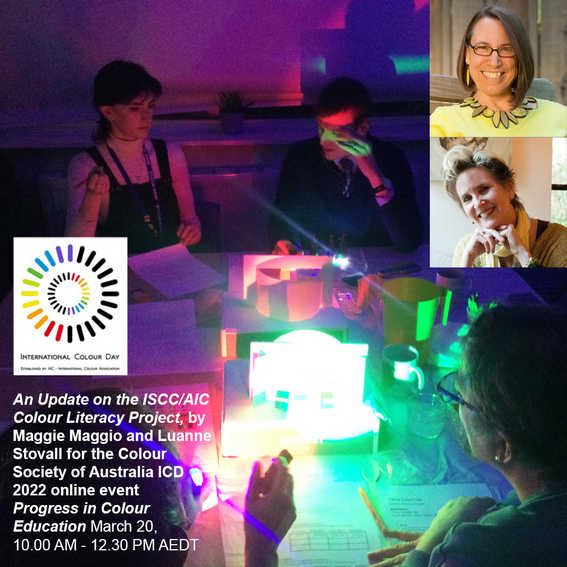
5. Implementing a Bottom-Up and Top-Down Approach; an Update on the Joint ISCC/AIC Colour Literacy Project, presented by Maggie Maggio and Luanne Stovall.
The Colour Literacy Project is an educational initiative of the Inter-Society Colour Council (ISCC) of the United States and the International Colour Association (AIC). Approved as a four-year joint project in January of 2020, the Colour Literacy Project is currently testing prototype resources for teaching 21st century color at both elementary schools and universities. As we hit the midpoint of the project, Maggie Maggio will report on the results of the first round of beta-testing with the teachers at St. Teresa’s Primary School in Manchester, England and Luanne Stovall will announce plans for a new Colour Literacy Forum, designed as an international platform that aligns university-level colour education with current design needs in the culture.
SPEAKER BIOGRAPHIES
Robert Hirschler has been actively involved in all aspects of color theory, color science and color technology since 1966. Robert graduated at the Technical University of Budapest in chemical engineering/textile chemistry. In 1967 he presented his first paper on computerized color matching and has been involved in colorimetry and color science ever since. He has been involved in AIC activities for over 40 years. He is an active member of both ProCor (Brazil) and the Hungarian National Color Committee and a member of the AIC Executive Committee. Since 2010 he has been the Chair of the Study Group on Color Education. His current research interest is the teaching of the basics of color science to architects, artists and designers as explained in his recent article How much color science is not too much? published in the journal Color Research and Application.
Robert’s co-author on the CLP committee Andreas Schwarz teaches Art and English at Staedtisches Maedchengymnasium in Essen Germany and is lecturer of Art education at University Duisburg-Essen. His interest in color was awakened by the numerous historical and current color diagrams and color sample collections, which he scientifically processed. This initially resulted in his PhD thesis Die Lehren von der Farbenharmonie (The Doctrines of Color Harmony) in 1999. His thesis was later followed by the publication of the outstanding monograph Color Ordered: A Survey of Color Systems from Antiquity to the Present in 2008 co-authored with Rolf G. Kuehni. Since then, his scientific focus has shifted to the use of color in art teaching, which culminated in a government-sponsored five-year research project. The results of his research, which for the first time shows the effects of imparting an outdated color theory on the behavior of students and teachers, was published in 2018 under the title Farbtheorie im Kunstunterricht - Eine qualitativ empirische Wirkungsforschung zum Umgang mit Farb; (Color Theory in Art Classes - A qualitative empirical research into the use of color).
David J. C. Briggs teaches painting, drawing and colour at the National Art School, and drawing at the University of Technology, Sydney. He has taught classes on color for painters for more than twenty years, including Theories of Colour, a Bachelor of Fine Arts lecture course on the theory and practice of color at the National Art School (2009-2011), and Understanding and Applying Colour, a NAS Public Programs Short Course available online since early 2020. David is the author of a major website on modern colour theory for painters, The Dimensions of Colour (launched 2007) and a curated collection of hundreds of links on all aspects of colour, Colour Online (launched 2020). His publications include a chapter, Colour Spaces, in the Routledge Handbook of Philosophy of Colour (2020). David is President and NSW Divisional Chair of the Colour Society of Australia and Co-chair of the AIC Study Group on Art and Design.
Robin Kingsburgh is a trained astronomer and painter. Her background in science comes from the University of Toronto (B.Sc. 1988) and University College London (Ph.D. in Astronomy, 1992). She worked as a postdoctoral fellow in Baja California at the University of Mexico from 1993-1996. Her painting experience comes from studies in Canada, France and the U.K, and has paralleled her scientific development. She has longstanding interests in the intersections of art, science and education. Robin currently teaches various natural science courses at York University, including Understanding Colour, The History of Astronomy, and The Nature of Time. She has curated numerous shows and events in the Toronto area, featuring artwork inspired by the ideas and methodologies of science. She co-President of the Colour Research Society of Canada, co-Chair of AIC 2022, and an elected member of the Ontario Society of Artists. Robin's website is at http://robinkingsburgh.com/.
Paul Green-Armytage taught in the School of Design at Curtin University for 30 years. He developed a research interest in colour and was awarded his PhD in 2006. He is a past president of the Colour Society of Australia and has served on the Executive Committee of the International Colour Association. He has presented papers at many conferences in Australia and overseas and has published articles in leading journals. He is currently a member of the Colour Literacy Project team.
Maggie Maggio retired from architecture in 2015 and now spends her time advocating for the integration of art and science in color education programs world-wide. After graduating with a BS in Interior Design from Drexel University and a Masters in Architecture from Syracuse University, Maggie spent thirty years working with and teaching color to artists and designers. Maggie is President-Elect of the Inter-Society Color Council (ISCC) of the US and the co-chair of the International Colour Association (AIC) Study Group on Color Education. Passionate about updating and expanding color education at all levels, Maggie is currently chairing the Colour Literacy Project, an educational initiative of the ISCC and the AIC to develop state-of-the-art resources for teaching 21st century color. Maggie's website is at maggiemaggio.com.
Luanne Stovall is an artist, color theorist, and lecturer at the University of Texas. Her paintings and works on paper have been exhibited widely in museums and galleries and are in private and public collections, including the Art Museum of South Texas; Blanton Museum, Austin, TX; Moakley Cancer Care Center, Boston; Neiman Marcus Signature Store, Boston; and the Estee Lauder Collection. Luanne attended the New York Studio School of Drawing, Painting, Sculpture in New York City, and Skowhegan School of Painting and Sculpture in Maine, and received an MFA from Tufts University. She has taught color workshops and courses at the UT Austin; The Contemporary Austin; the American Institute of Architects (AIA); School of the Museum of Fine Arts, Boston; Wellesley College, MA; and MIT’s Sloan School of Business. She is a Board Director of the Inter-Society Color Council and a member of the steering team of the global Color Literacy Project. Luanne's website is at Luannestovall.com.
